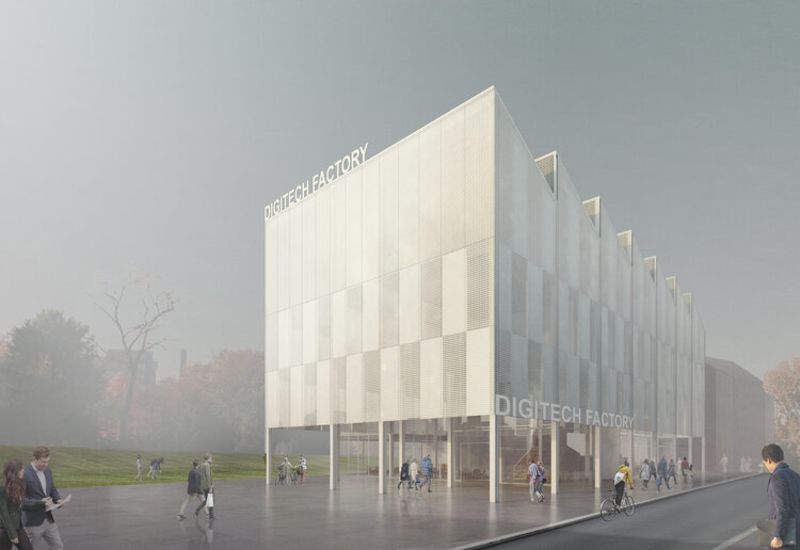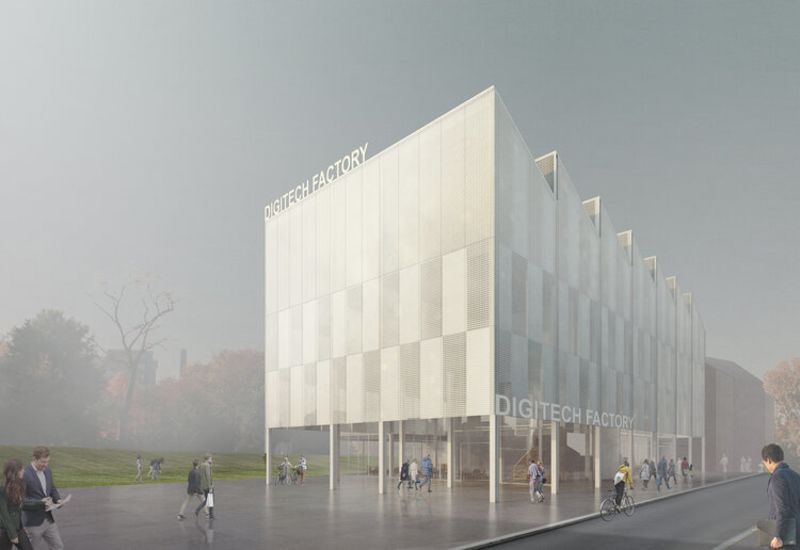
XLwerks projects a bright future for mixed reality with Trimble XR10
James Lee Studio

XLwerks is an architectural design practice based in Norwich (UK) that was conceived as a collaborative concept. In this brainchild of founder James Lee Burgess, a team of architects, urban planners, sustainability experts, interior designers and technology experts works together on urban planning and designs, interior landscapes and future-proof buildings. Focus is on collaboration, innovation and technology, all leading to integral sustainable designs.
“Our collaborative mindset, combined with a high level of technology adoption, enables us to tackle sizable and complex projects with a small core team,” says Lee. “As a team we are constantly looking for solutions that help us to not only deliver better design work, but also enhance our customers’ involvement and engagement in the design process.” For XLwerks, collaboration also means making the client an integral part of the process. And it is this set of qualities that has made the company move into mixed reality content design.
Mixed reality
To bring its designs to life for its clients, XLwerks acquired two Microsoft Hololens and two Trimble XR10 mixed reality devices. The XR10 is developed on Microsoft’s Hololens 2 technology and features holographic glasses mounted on a standard type hardhat. It is the only safety-certified HoloLens device available. The wearer can view and interact with 3D designs projected as an overlay over the real world. Head tracking and eye tracking makes for high accuracy, a microphone and a Bluetooth headset with bone-conduction enables two-way communication with the office. Gesture control enables the user to truly interact with models stored in the cloud and accessed through Trimble Connect for HoloLens software.
Collaborative design
XLwerks launched a program called ConstructXR, a mixed reality program, and under that umbrella is working on a collaborative design project, the Digi-Tech Factory (DTF) Building for City College in Norwich. The DTF is designed to be an inspirational facility for digital skills development for students of Norwich and beyond. The new four floor building will be instrumental in the continued growth of regional digital education provision. The college is keen to play a key role in delivering innovative, industry-standard learning. It has developed a digital skills curriculum with strong input from employers from the region.
From brief to handover
“ConstructXR is delivering training to project partners in the use of the mixed reality devices and the Trimble Connect for Hololens, demonstrating its capabilities in the design process: from the initial brief stage up until final handover of the building. We’re all about continually improving the practical implementation of Mixed Reality as there is an enormous potential in terms of project efficiency and transparency. We are recording our findings to overcome challenges faced onsite and highlighting where potential improvements can be made.”
On the Digi-Tech project, XLwerks works with the whole design team (RG Carter Construction, Coffey Architects, Clear Consulting and Design and Clancy Consulting) bringing their 3D design to life through mixed reality. The designs are all stored in the Building Information Model (BIM) and with the help of Trimble Connect for HoloLens, the designs are available on site at scale. All this helps the contractors on the project to get a feel for the building and its scale. Their feedback is logged for future reference while they virtually travel through the construction project, which is helpful in getting the design fine tuned.
Engagement boost
Lee, “What we find is that design professionals, once they get into the technology – which takes only about 15-20 minutes – are without exception enthusiastic about the possibilities.” On the Norwich Castle Museum renovation project, another construct.XR project that the Trimble XR10 is being used on, XLwerks gave Conisbee Structural Engineers the possibility to see their steel structure design come to life in the real world through mixed reality. Norwich Castle Keep, the five-level structure at the heart of the bigger castle complex, is a twelfth-century castle. It is being maintained and managed by the Norfolk Museums & Archaeology Service. In this project, part of the bigger Gateway to Medieval England initiative, all five floors of the Castle Keep will be opened up and made accessible through a steel structure with staircases and walks. Visitors will then be able to see the Castle Keep as it looked at the time when it was a Norman medieval palace
To-Do list
Seeing their design projected as a mixed reality overlay of the real-world situation with Trimble XR10, the structural engineers could immediately put in their to-do items in the design. The museum client meanwhile got to see an impression of the finished product and got a real feel for what the end result would look like, which Lee says helped tremendously in terms of engagement. Conisbee have since asked XLwerks to assist them further with the coordination of the steel structure with the existing fabric.
Game changer
XLwerks, through its digital collaboration business strategy, believes the Trimble XR10 to be a real game-changer in the field of construction. The company already was an avid user of Trimble’s SketchUp 3D design software, and with the XR10 now has a novel way to quickly present 3D design concepts to clients. The possibilities for the mixed reality technology stretch far beyond construction alone. XLWerks is now exploring the possibilities of using the Trimble XR10 in marketing initiatives and is training firms to use the technology as well. Lee concludes, “There is a huge potential for technology like this in different areas, anywhere where you want to present a customer with an idea and have them truly interact with the concept in a penetrating way.”
You can view the original article here on Trimble
Get in touch with James Lee Works